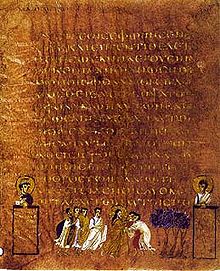- Sinope Gospels
-
New Testament manuscripts
papyri • uncials • minuscules • lectionariesUncial 023
A page from the Sinope Gospels. The miniature at the bottom shows Christ healing the blindName Sinope Gospels Sign O Text Gospel of Matthew Date 6th century Script Greek Found Sinope 1899 Now at Bibliothèque nationale de France Size 30 x 25 cm Type Byzantine Category V The Sinope Gospels, designated by O or 023 (in the Gregory-Aland numbering), ε 21 (Soden), also known as the Codex Sinopensis, is a fragment of a 6th century illuminated Greek Gospel Book. Along with the Rossano Gospels, the Sinope Gospels has been dated, on the basis of the style of the miniatures, to the mid-6th century. The Rossano Gospels, however are considered to be earlier. Like Rossanensis and the Vienna Genesis, the Sinope Gospels are written on purple dyed vellum.
Contents
Description
There are only 44 extant folios in the Sinope Gospels. These folios carry unframed miniatures at the bottom of the page which are similar in style to the miniatures in the Rossano Gospels. The folios measure approximately 30 cm by 25 cm. It is written in one column per page, 15 lines per column, in silver writing and gold.[1] It is written in very large uncial letters. The manuscript is very lacunose.
- Contents
- Matthew 7:7-22; 11:5-12; 13:7-47; 13:54-14:4.13-20; 15:11-16:18; 17:2-24; 18:4-30; 19:3-10.17-25; 20:9-21:5; 21:12-22:7.15-14; 22:32-23:35; 24:3-12.
- It contains five illuminated miniatures
- the festival of Herod and death of John the Baptist (folio 10 verso)
- five thousand fed (folio 11 recto)
- four thousand fed (folio 15 recto)
- the healing of a blind man from Jericho (folio 29 recto)
- the cursing of the fig tree (folio 30 verso).
History
It was written in the 6th century. The style of illustrations suggests Syria or Palestine (even Mesopotamia) as the place of its origin. The codex was discovered in 1899 at Sinope (hence its name), by a French officer.[2] Its text was published by Henri Omont in 1901.
43 leaves (all but one) of the codex now are located at the Bibliothèque Nationale of the Manuscrits occidentaux (Supplement Grec. 1286) at Paris.[1]
According to B. H. Streeter it is a tertiary witness of the Caesarean text-type. This opinion was supported by Bruce Metzger.[3] Aland placed it in Category V, which means the Byzantine text-type.[1]
See also
References
- ^ a b c Aland, Kurt; Barbara Aland; Erroll F. Rhodes (trans.) (1995). The Text of the New Testament: An Introduction to the Critical Editions and to the Theory and Practice of Modern Textual Criticism. Grand Rapids: William B. Eerdmans Publishing Company. p. 113. ISBN 978-0-8028-4098-1.
- ^ C. R. Gregory, "Textkritik des Neuen Testaments", J.C. Hinrichs’sche Buchhandlung: Leipzig 1909, vol. 3, p. 1023.
- ^ Bruce M. Metzger, and Bart D. Ehrman, The Text of the New Testament: Its Transmission, Corruption, and Restoration, Oxford University Press, New York, Oxford 2005, p. 79.
Further reading
- H. Omont, Notice sur un très ancien manuscrit grec de l'évangile de saint Matthieu..., Notices et extraits des manuscrits de la bibliothèque nationale..., vol. 36 (Paris, 1901), pp. 599–676.
- H. S. Cronin, Codex Chrysopurpureus Sinopensis, JTS II (1901), pp. 590-600.
- A. Munoz, Il codice purpureo di Rossano e il frammento sinopense (Rome 1907)
- C. R. Gregory, Textkritik des Neuen Testaments (J.C. Hinrichs’sche Buchhandlung: Leipzig 1909), vol. 3, pp. 1022–1023.
- Petra Sevrugian, Der Rossano-Codex und die Sinope-Fragmente: Miniaturen und Theologie (Worms 1990)
External links
Categories:- Gospel Books
- Purple parchment
- Greek New Testament uncials
- Bibliothèque nationale de France collections
Wikimedia Foundation. 2010.

